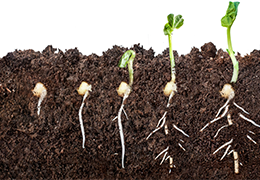What is the importance of soil texture in a garden?
Ferry-Morse Home Gardening Blog | 2024
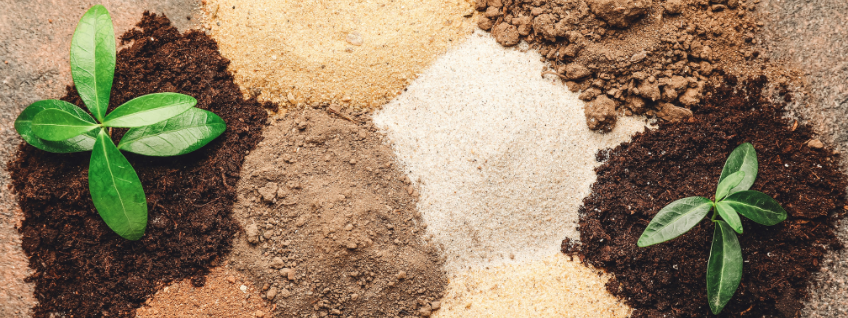
Small mounds of different soil types with two green leafy plants growing in organically-rich soil
As gardeners, nothing immerses us in a state of euphoria more than sinking our hands into a bed of rich chocolate-cakey garden soil ready for planting. But have you ever wondered, how does soil get its texture?
In this article, we'll cover the different types of soil textures, why they're essential, and how texture works with other components to complete the soil recipe, so you'll know how to whip up your very own batch of life-sustaining garden soil at home. Let's see what we can dig up.
What's soil?
So, you might be wondering, is soil just dirt? Well, not exactly.
Soil is a habitat consisting of organic and mineral elements and living and decomposing organisms. It holds and provides water and nutrients to plants and provides an anchoring substrate to support growth.
Its quality and structure are essential for plant health and it has biological, chemical, and physical properties. And texture is just one of those physical properties.
So, while it can make our hands dirty, soil is a whole lot more than just dirt. It's pretty simple, right?

Agronomist taking soil samples in a field with a bucket, soil-analyzer device, trowel, and clipboard
What’s soil made of?
Minerals are the remains of rock and sediments that broke down over eons to form sand, silt, and clay.
And they are the most significant component, as mineral content can take up nearly half the volume in a cubic foot of soil across soil types.
So why does this matter? Well, minerals are what give soil its texture. Let's get to the nitty-gritty.
What’s soil texture?
A soil's texture is determined by its relative proportions of sand, silt, and clay. Let's take a closer look.
What is the difference between sand, silt, and clay?
Mineral particles range from microscopic to large enough to see without a microscope. Sand particles are the largest, and clay's the smallest. Silt particles fall in-between sand and clay.
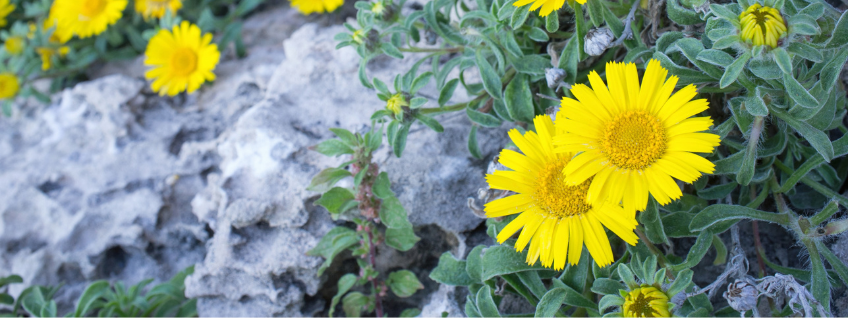
Yellow daisies growing on silver-gray rocky soil
It's inorganic, and that's OK
Since soil particles are made of minerals, they don't decompose over time. In fact, soil texture is inorganic because it comes from weathered rocks, which, while natural, aren't once-living things.
But that's only part of the story because texture refers to particle size and not the mineral's constitution.
It's why there's a white sand beach in Miami and a black sand beach in Maui because they're made of different minerals, even though they're both sandy soils. Makes complete sense, right?

Waves crashing onto a black sand beach surrounded by vibrant green vegetation
How to determine my soil's texture?
Here’s the deal: Just about all soils—including garden soils—contain a combination of soil textures. But you might be wondering how to find out where your soil’s texture falls on the triangle.
A super-simple test you can perform at home is the jar method to determine the different textures present in a soil sample. The ribbon method is another simple way to determine soil texture.
Or, place some moist soil in your palm and squeeze it hard. If it forms a ball that sticks together, it's a clay soil type because clay's defining characteristic is the ability to maintain a molded shape.
Alternatively, a loose ball that falls apart quickly is most likely a loam soil type or it contains a lot of organic matter.
Kansas State University's Agricultural Experiment Station and Cooperative Extension Service published this handy guide that shows you how to estimate soil texture by feel, including an easy-to-read diagram and flowchart.
Finally, soil tests that describe a soil sample's composition are available through your local master gardeners association or agricultural extension office. Let's move on.
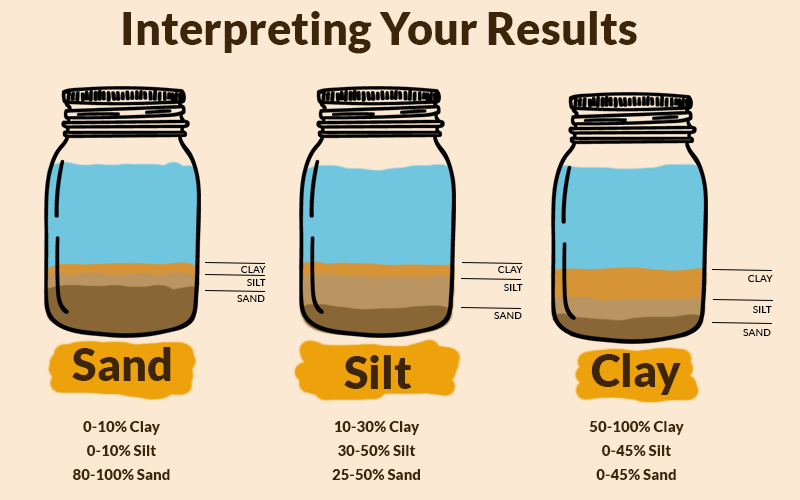
Diagram showing results of the jar method and interpretations
Compacted soil
A fun fact is that some home gardeners think they have clay soil when, in fact, they have compacted soil.
There's a good chance fill dirt surrounds your home, which tends to compress and isn't the best for gardening.
So, you'll want to be sure to take a little time to find out what you have, which is totally doable even with a busy lifestyle.
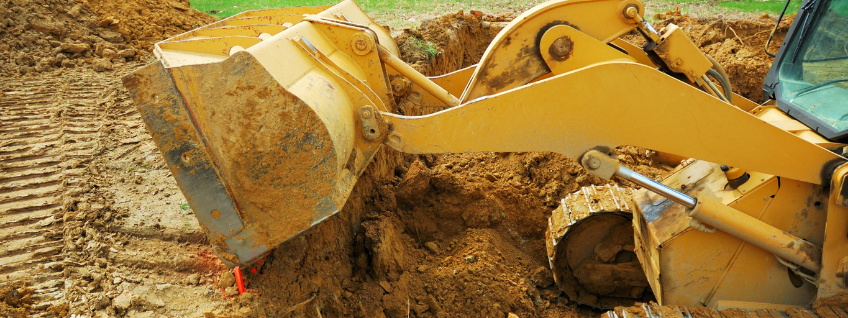
Excavator moving dirt for new home construction
How does texture affect garden soil?
In truth, the minerals forming your soil's texture are an inorganic constant in your garden. They aren’t changing or going anywhere.
On the other hand, any organic amendment or top dressing you add will decompose, replicating one of the processes that create good soil structure in nature.
According to Melinda Myers, Horticulturist and Certified Arborist, 100 pounds of compost breaks down to about 10 pounds at the end of one year. Only about one pound of that same compost will remain by the end of the following year.
So, while organic matter is constantly breaking down, the mineral component of your soil remains the same. Let's learn more.
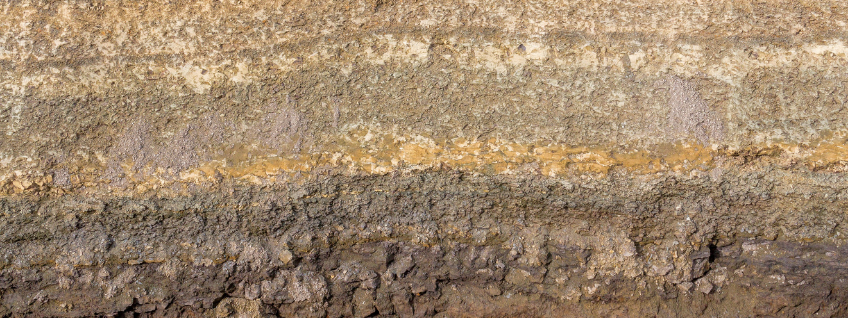
Cross-section of a soil sample showing different layers
Sand, silt, clay, and loam soils
Sand
Sand is loose and gritty but not sticky and feels about the same whether wet or dry. Soil composition must have at least 85 percent sand to fall into this category.
Sand particles are the coarsest of all soil textures, ranging from 0.05 to 2 millimeters (mm) in diameter. So, you can see individual sand particles without the need for a magnifying glass.
Sand's large particles make it an excellent amendment for making heavier soils easier to till and dig. However, it is the least effective soil texture for nutrient retention.
It drains well, retaining the least amount of water of all soil textures, about 1 inch per foot of soil depth. Sandy soil dries out the quickest of all soil textures, especially in hot weather.
In short, it’s why sandcastles fall apart as soon as they dry—because the main thing holding them together is the surface tension of the water. Once the bonds break through evaporation, your
So, you'll need to water sandy soil more often and amend or top dress it to improve its water and nutrient-holding capacity, adding a layer of mulch to increase moisture retention.

A small child building a sand castle on a tropical beach
Silt
Ever strolled on the edge of a river and noticed thin cakes of cracked soil that appeared to be peeling at the edges? That’s silt.
Silt is soft and very smooth, having a floury, powdery feel. It retains an impression when dry and stays smooth but not slick or sticky when wet. To qualify, the soil must contain at least 80 percent silt and less than 12 percent clay.
Its particle size is medium, ranging from 0.002 to 0.05 mm in diameter, requiring a magnifying glass to see individual particles. Its moisture-retention ability is moderate, between 1–2 inches per foot of soil depth.
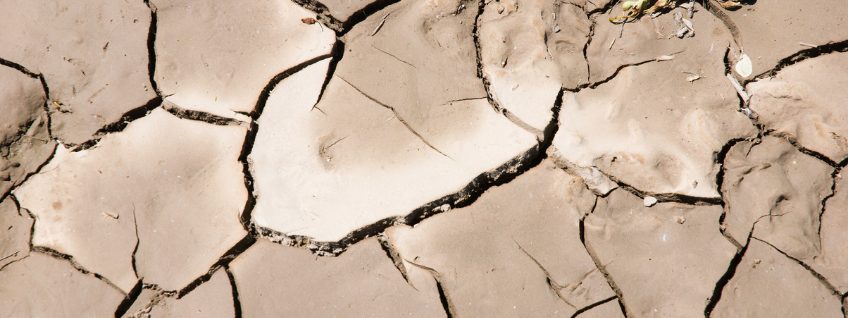
Pale-colored, dried silt with cracks throughout
Clay
Clay is heavy and can hold a molded form. Slick and sticky when wet, it can be very hard to break apart when dry. Soil composition must be at least 40 percent clay, less than 45 percent sand, and less than 40 percent silt to be this soil texture.
Clay’s particle size is the finest of all soil textures, about 0.002 mm or less in diameter. A microscope is required to see individual particles. Of all soil textures, it retains the most moisture, between 2–2.5 inches per foot of soil depth.
Clay will hold water for a prolonged period, oversaturating easily. So, aeration is very poor in these heavy soils, and clay's soil density can restrict root growth.
In short, clay particles dominate other soil textures. Their water holding capacity makes soil heavy, which can be challenging to work with, as we've all heard many home gardeners bemoan (and maybe you have too).
So, is clay all that bad?
Well, no. It's quite beneficial!
An interesting fact about clay is that it is a key element in nutrient retention.
Here's how it works: Its particles hold a negative charge, which binds to positively-charged nutrient molecules and can release them through a process called cation exchange.
In other words, it's essential for gardening! All soils need at least some clay to retain and release nutrients.
So,
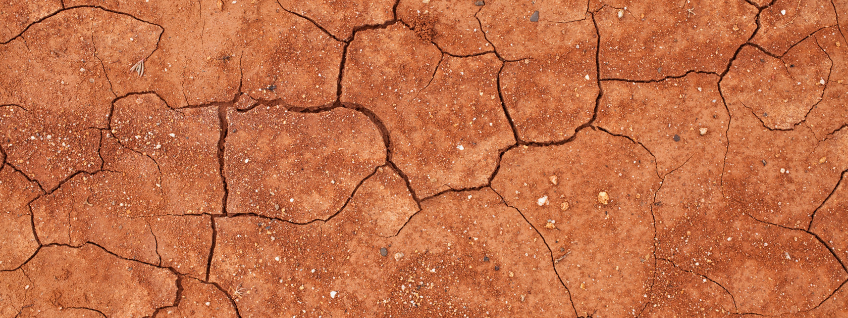
Red clay soil with cracks throughout
Loam
Loam feels gritty, smooth, and slightly sticky.
Its composition is less than 27 percent clay, less than 50 percent silt, and 52 percent or less sand. Since it's a balance of the three primary textures, particle size is fine to coarse. And its ability to retain water is moderate, ranging from 1–2 inches per foot of soil depth.
Loam is considered the ideal soil texture for planting because it drains well, retains nutrients, and provides a friendly habitat for garden-helping organisms.
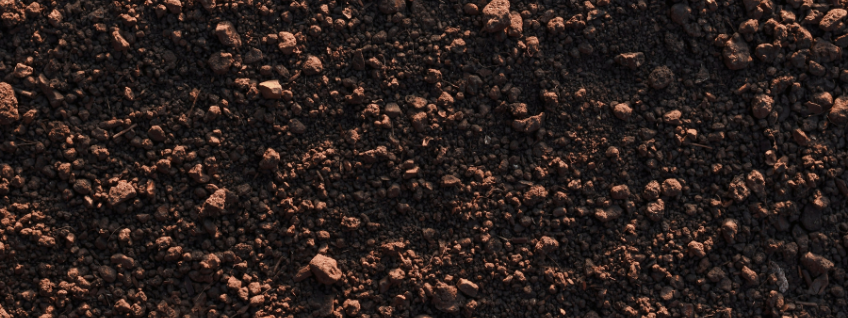
Loam soil showing the combination of different particle sizes
Other textures
There are many other textures on the soil textural triangle. So, instead of describing them all here, consider heading to the websites below to learn directly from top experts.
The USDA Natural Resources Conservation Service covers soil texture classes and subclasses extensively.
Take it a step further by scrolling through a presentation on soil components and basic chemistry put together by Justin Scheiner, Ph.D. of Texas A&M University.
So be sure to check them out!
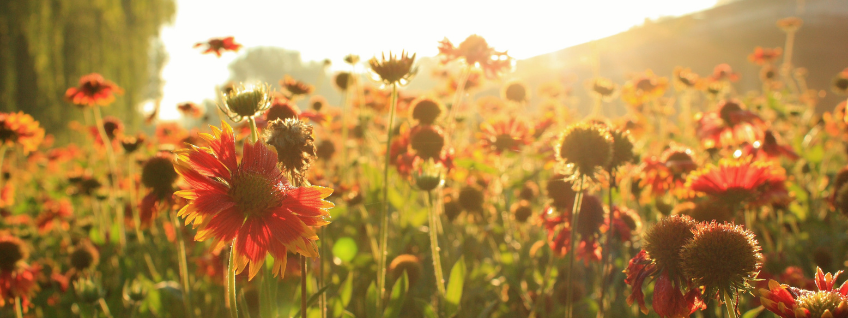
A field of Gaillardia flowers in bloom under soft sunlight
What can I grow in different soil textures?
Gaillardia loves sandy soils. And loamy sand's high sand content helps it warm up fast in the spring, making it ideal for heat-loving and shallow-rooted plants, like okra.
For plants that mature in or on the ground like carrots and watermelon, a sandy medium helps them grow properly.
Silty soils with clay can provide a good structure for growing plants. Plants that thrive in silty clay loam include sunflower, coreopsis, and ornamental grasses.
Loamy soil types with compost added tend to create a fantastic structure for growing most vegetables and flowers.
Sandy clay loam is excellent at retaining water and nutrients while providing adequate drainage. As a result, most plants grow well in this texture. Flowering bulbs love sandy loam.
Some clay soils are better for native plants that evolved to tolerate their texture. Sandy clay is suitable for growing leeks. And believe it or not, even heavy clay can support some plants, such as
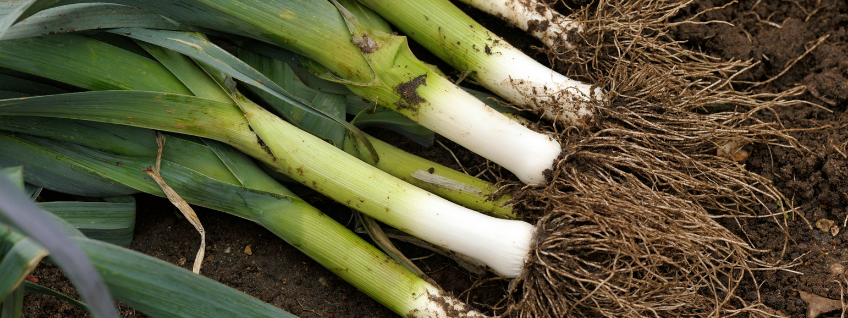
Freshly-lifted leeks in a vegetable garden
Can I improve my soil’s texture?
Here’s the truth: It's better to focus on improving your soil’s overall quality because texture is pretty hard to change. Accomplish this by amending or top-dressing it with organic matter like compost.
Removing large sections of earth and replacing them with different-textured soil isn’t practical for the average home gardener. However, you can purchase or create your own soil mix on a relatively small scale for containers, including raised beds.
So, unless you plan to garden in containers exclusively, it's best to consider plant varieties that perform well in your soil's existing texture and environmental conditions. After all, you might find out that your existing texture holds more promise than you think!
An excellent place to start is by reaching out to your local agricultural extension office or master gardeners association for recommendations.
And you might want to explore the benefits of biochar, an inorganic material that helps build a good soil structure.

Clay pots with peat, perlite, and vermiculite pouring out
How important is organic matter?
Organic matter might be dead and decaying but it’s what gives soil life.
And the best part is that while soil texture is independent of the organic component of soil, they work together with air and water to create soil structure.
Organic matter plays an important role in preparing soil for planting by improving drainage, increasing water retention, supporting micro and macro organisms, and providing slow-release nutrients for uptake by plants.
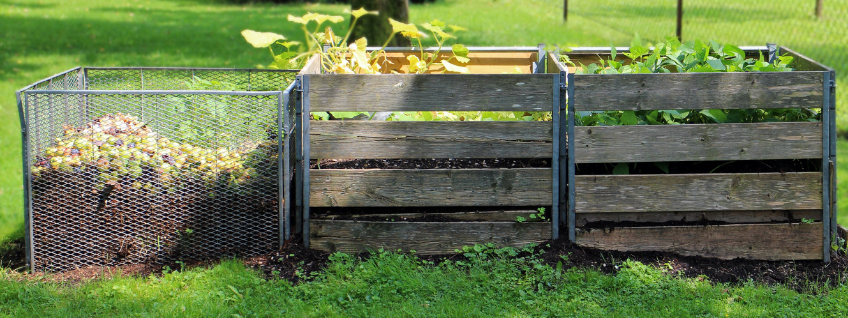
A home gardener's composting station showing three separate bins representing the various stages of decomposition
So, what did we dig up?
We’ve unearthed some important and interesting facts but the thing to remember is this: No matter your soil's texture, you can still have a beautiful, productive garden.
All you need to do is figure out what you have and formulate a strategy to achieve a healthy soil structure. It’s that simple.
Also, while
For example, the seed packet for African Daisy seeds says it prefers light, dry, and not too rich soil. So, take the next step by determining what textural class might be best—not only for this variety but for any variety you want to try.
And as always, we're available to help via our Gardener's Helpline®. So, please reach out if you need us!
CLICK HERE TO EXPLORE THE REST OF THE FERRY-MORSE GARDENING BLOG -->


